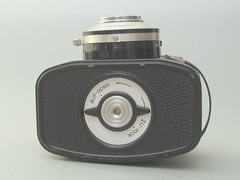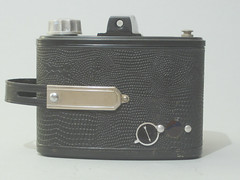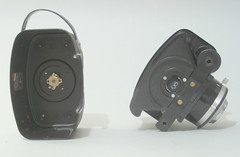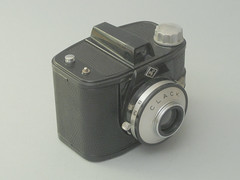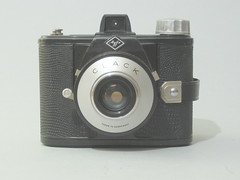Difference between revisions of "Clack"
m (→Intelligent solutions) |
Hanskerensky (talk | contribs) (Added link to user manual page) |
||
| (30 intermediate revisions by 11 users not shown) | |||
| Line 1: | Line 1: | ||
| − | + | {{Flickr_image | |
| − | + | |image_source= http://www.flickr.com/photos/andrys_stienstra/3159788581/in/pool-camerawiki | |
| + | |image= http://farm4.static.flickr.com/3076/3159788581_9de05bbc20.jpg | ||
| + | |image_align= right | ||
| + | |image_text= Agfa Clack | ||
| + | |image_by= Andrys Stienstra | ||
| + | |image_rights= non-commercial | ||
| + | }} | ||
| + | The '''Clack''' was manufactured by [[Agfa]] from 1954–65. Earlier models had a metal body, later ones were made of plastic. It is a simple camera not unlike certain tea-tins, with a single-element 95mm [[meniscus lens]]. While the lens does not focus, a secondary close-up lens may be flipped into place for nearer subjects. It takes 6×9 cm pictures on [[120 film]]. | ||
| − | + | == Designed for economy == | |
| − | + | To enable a simple meniscus lens to achieve reasonable sharpness, it is permanently stopped down to a small aperture (f/10 or less). The large 6×9 cm negative size requires little or no enlargement to create usable prints, so any flaws in the image are less noticeable. One feature to note is rounded camera back. There's no pressure plate inside the camera—the film isn't supposed to be held flat. The camera body is oval shaped when viewed from above, and the film is fed around the curved back of the camera to help match the curved plane of focus of the meniscus lens. This is a clever engineering solution to help keep camera costs low (one later adopted by many plastic 35mm [[trashcam]]s). | |
| − | + | ==Specifications== | |
| − | |||
| − | + | * Two apertures, roughly f/13 (sun icon) and f/10 (clouds icon) | |
| + | * Shutter about 1/30 plus B | ||
| + | * Built-in yellow filter (on some examples) | ||
| + | *Zone focusing with two steps: | ||
| + | ** 1-3m (3-10 feet) with a built-in close-up lens (whose aperture is the same ~f/10 as the "cloudy" setting) | ||
| + | ** 3m (10 feet)-infinity (with either of the open aperture stops in place behind the lens) | ||
| + | == Shooting with a Clack == | ||
| − | + | While somewhat bulky, the Clack is a fun, lightweight camera to use. The 6×9 image format means that a roll of 120 film is finished after 8 shots, which may be an advantage for those impatient to see their results. Exposures using the "weather" symbols are suitable for film speeds in the range of ISO 125 down to ISO 50 (so even Velvia slide film might be tried). For greatest versatility, an ISO 400 negative film would give better exposures in deep shade or heavy overcast, but would have the latitude to tolerate a few stops of overexposure in full sun. | |
| − | + | ||
| − | + | Some samples are equipped with a yellow filter, useful when shooting Black & White film to help deepen skies and reduce haze. Unusually for this class of camera, the Clack offers a tripod socket and accepts a cable release, so even some night photography using the "B" shutter setting becomes possible. | |
| − | |||
| − | |||
| − | |||
| − | |||
| − | == | + | == All-around views == |
| + | <div> [http://www.flickr.com/photos/50678983@N00/272119833/in/pool-camerawiki/ http://static.flickr.com/96/272119833_5aba0f237d_m.jpg][http://www.flickr.com/photos/50678983@N00/272119831/in/pool-camerawiki http://static.flickr.com/117/272119831_76429683ee_m.jpg][http://www.flickr.com/photos/50678983@N00/272119834/in/pool-camerawiki/ http://static.flickr.com/83/272119834_68b615b7b1_m.jpg][http://www.flickr.com/photos/50678983@N00/272119837/in/pool-camerawiki/ http://static.flickr.com/92/272119837_97158ee4d7_m.jpg][http://www.flickr.com/photos/50678983@N00/272119836/in/pool-camerawiki/ http://static.flickr.com/108/272119836_925aed01bb_m.jpg]</div> | ||
| − | + | Images by [[:Category:image by Dries van den Elzen|Dries van den Elzen]] {{with permission}} | |
==Links== | ==Links== | ||
| − | * http://cameras.alfredklomp.com/clack/index.htm | + | *[https://www.butkus.org/chinon/agfa/agfa_clack_6x9/agfa_clack_6x9.htm Agfa Clack user manual] at [https://www.butkus.org/chinon/ Butkus.org] |
| − | * http://www.rolandandcaroline.co.uk/clack/clack.html | + | * [http://cameras.alfredklomp.com/clack/index.htm AGFA Clack] at [http://cameras.alfredklomp.com/ Alfred's Camera Page] |
| + | * [http://www.rolandandcaroline.co.uk/clack/clack.html AGFA Clack] at [http://www.rolandandcaroline.co.uk/ Roland and Caroline's Homepage] | ||
| − | [[Category: 6x9 viewfinder | + | [[Category: German 6x9 viewfinder]] |
| − | |||
[[Category: Agfa]] | [[Category: Agfa]] | ||
[[Category: C]] | [[Category: C]] | ||
| + | [[Category:image by Dries van den Elzen]] | ||
| + | [[Category:120 film]] | ||
Latest revision as of 05:35, 12 March 2023
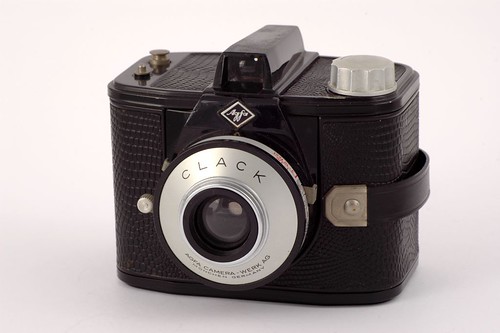
|
| Agfa Clack image by Andrys Stienstra (Image rights) |
The Clack was manufactured by Agfa from 1954–65. Earlier models had a metal body, later ones were made of plastic. It is a simple camera not unlike certain tea-tins, with a single-element 95mm meniscus lens. While the lens does not focus, a secondary close-up lens may be flipped into place for nearer subjects. It takes 6×9 cm pictures on 120 film.
Designed for economy
To enable a simple meniscus lens to achieve reasonable sharpness, it is permanently stopped down to a small aperture (f/10 or less). The large 6×9 cm negative size requires little or no enlargement to create usable prints, so any flaws in the image are less noticeable. One feature to note is rounded camera back. There's no pressure plate inside the camera—the film isn't supposed to be held flat. The camera body is oval shaped when viewed from above, and the film is fed around the curved back of the camera to help match the curved plane of focus of the meniscus lens. This is a clever engineering solution to help keep camera costs low (one later adopted by many plastic 35mm trashcams).
Specifications
- Two apertures, roughly f/13 (sun icon) and f/10 (clouds icon)
- Shutter about 1/30 plus B
- Built-in yellow filter (on some examples)
- Zone focusing with two steps:
- 1-3m (3-10 feet) with a built-in close-up lens (whose aperture is the same ~f/10 as the "cloudy" setting)
- 3m (10 feet)-infinity (with either of the open aperture stops in place behind the lens)
Shooting with a Clack
While somewhat bulky, the Clack is a fun, lightweight camera to use. The 6×9 image format means that a roll of 120 film is finished after 8 shots, which may be an advantage for those impatient to see their results. Exposures using the "weather" symbols are suitable for film speeds in the range of ISO 125 down to ISO 50 (so even Velvia slide film might be tried). For greatest versatility, an ISO 400 negative film would give better exposures in deep shade or heavy overcast, but would have the latitude to tolerate a few stops of overexposure in full sun.
Some samples are equipped with a yellow filter, useful when shooting Black & White film to help deepen skies and reduce haze. Unusually for this class of camera, the Clack offers a tripod socket and accepts a cable release, so even some night photography using the "B" shutter setting becomes possible.
All-around views
Images by Dries van den Elzen (Image rights)
